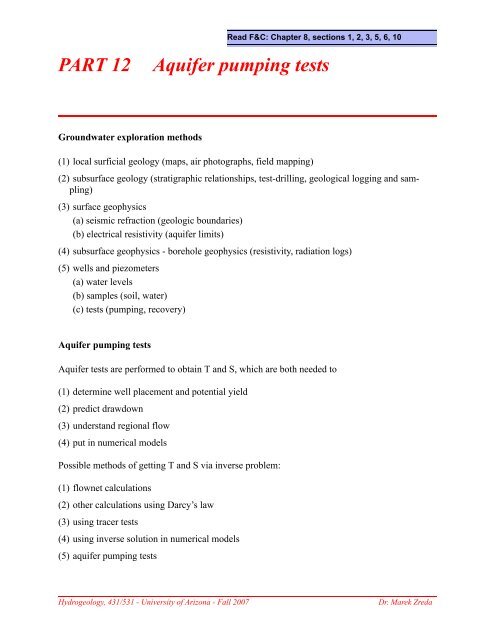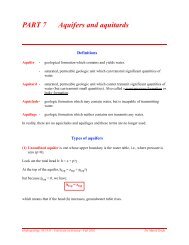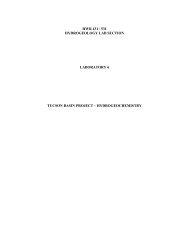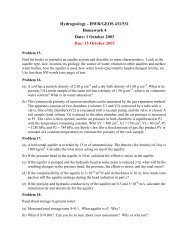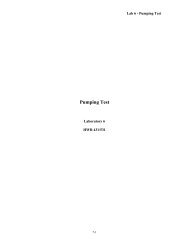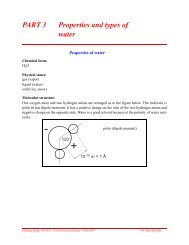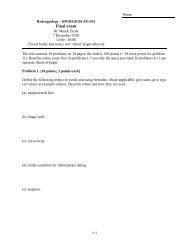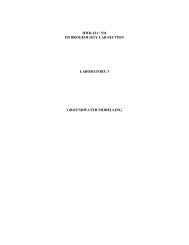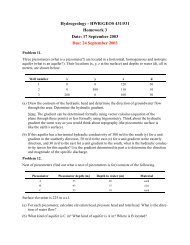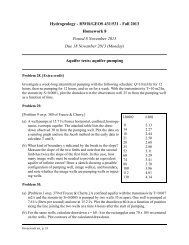PART 12 Aquifer pumping tests - Dr. M. Zreda - University of Arizona
PART 12 Aquifer pumping tests - Dr. M. Zreda - University of Arizona
PART 12 Aquifer pumping tests - Dr. M. Zreda - University of Arizona
Create successful ePaper yourself
Turn your PDF publications into a flip-book with our unique Google optimized e-Paper software.
<strong>PART</strong> <strong>12</strong> <strong>Aquifer</strong> <strong>pumping</strong> <strong>tests</strong><br />
Groundwater exploration methods<br />
(1) local surficial geology (maps, air photographs, field mapping)<br />
(2) subsurface geology (stratigraphic relationships, test-drilling, geological logging and sampling)<br />
(3) surface geophysics<br />
(a) seismic refraction (geologic boundaries)<br />
(b) electrical resistivity (aquifer limits)<br />
(4) subsurface geophysics - borehole geophysics (resistivity, radiation logs)<br />
(5) wells and piezometers<br />
(a) water levels<br />
(b) samples (soil, water)<br />
(c) <strong>tests</strong> (<strong>pumping</strong>, recovery)<br />
<strong>Aquifer</strong> <strong>pumping</strong> <strong>tests</strong><br />
<strong>Aquifer</strong> <strong>tests</strong> are performed to obtain T and S, which are both needed to<br />
(1) determine well placement and potential yield<br />
(2) predict drawdown<br />
(3) understand regional flow<br />
(4) put in numerical models<br />
Possible methods <strong>of</strong> getting T and S via inverse problem:<br />
(1) flownet calculations<br />
(2) other calculations using Darcy’s law<br />
(3) using tracer <strong>tests</strong><br />
(4) using inverse solution in numerical models<br />
(5) aquifer <strong>pumping</strong> <strong>tests</strong><br />
Read F&C: Chapter 8, sections 1, 2, 3, 5, 6, 10<br />
Hydrogeology, 431/531 - <strong>University</strong> <strong>of</strong> <strong>Arizona</strong> - Fall 2007 <strong>Dr</strong>. Marek <strong>Zreda</strong>
<strong>Aquifer</strong> <strong>pumping</strong> <strong>tests</strong> 88<br />
Assumptions:<br />
Steady state <strong>pumping</strong> test<br />
(1) Homogeneous, isotropic, confined aquifer with steady flow, 3-D<br />
(2) Horizontal flow: 3-D changes to 2-D<br />
(3) Impervious top and bottom and constant aquifer thickness b<br />
(4) Prescribed head boundary around the well, i.e., “well on an island” setting. Water comes from<br />
a lateral boundary only (Theis assumption).<br />
(5) Radial 1-D flow towards the well<br />
(6) Well fully penetrates (compare to assumption 2); if not, then we will have vertical component<br />
(7) Well pumps at a constant rate Q; Q appears as a boundary condition<br />
PDE:<br />
∇ xy<br />
∇ h 2 = 0 in 3-D<br />
2<br />
h = 0 or<br />
x 2<br />
∂ h<br />
∂ y 2<br />
∂ h<br />
+ = 0<br />
∂<br />
1<br />
--<br />
∂ ⎛ ∂h<br />
r-----⎞ = 0 Laplace equation for radial flow<br />
r ∂r⎝<br />
∂r⎠<br />
=<br />
;;;;<br />
;;;; yyyy ;;;; yyyy<br />
yyyyh<br />
h = H<br />
lake lake<br />
1<br />
--<br />
∂ ⎛ ∂h<br />
r-----⎞ =<br />
0<br />
r ∂r⎝<br />
∂r⎠<br />
h 2<br />
r 2<br />
h 1<br />
r 1<br />
Q<br />
R<br />
b<br />
Hydrogeology, 431/531 - <strong>University</strong> <strong>of</strong> <strong>Arizona</strong> - Fall 2007 <strong>Dr</strong>. Marek <strong>Zreda</strong><br />
2<br />
2<br />
H<br />
q increases close to the well. Why?
<strong>Aquifer</strong> <strong>pumping</strong> <strong>tests</strong> 89<br />
Boundary conditions:<br />
BC1: Prescribed head at the lake:<br />
h = H at r = R<br />
BC2: Prescribed flux at the well (= <strong>pumping</strong> rate Q):<br />
Q = K(2πrb)(∂h/∂r) at r = r w (well radius)<br />
or, after rearranging and putting T = Kb:<br />
---------<br />
Q<br />
r<br />
2πT<br />
h ∂<br />
= -----<br />
∂r<br />
Solution:<br />
Integrate once:<br />
Use BC2: C 1 = Q/(2πT)<br />
Rearrange by grouping r terms together<br />
Integrate<br />
Use BC1:<br />
r h ∂<br />
----- = C1 ∂r<br />
∂r<br />
∂h = C1---- r<br />
Q<br />
h = C1lnr + C2 = --------- lnr + C2 2πT<br />
C 2<br />
Q<br />
= H – --------- lnR<br />
2πT<br />
Final solution for h becomes<br />
h – H<br />
---------<br />
Q r<br />
=<br />
⎛ln- ⎞<br />
2πT ⎝ R⎠<br />
Thiem equation<br />
Hydrogeology, 431/531 - <strong>University</strong> <strong>of</strong> <strong>Arizona</strong> - Fall 2007 <strong>Dr</strong>. Marek <strong>Zreda</strong>
<strong>Aquifer</strong> <strong>pumping</strong> <strong>tests</strong> 90<br />
For two observation wells (h 1 and h 2 in the figure above):<br />
Graphically, the solution is<br />
s = drawdown = s(r)<br />
at r = R, s = 0 (no drawdown at the lake)<br />
Suppose r1 = rw r2 = R<br />
then<br />
h2 –<br />
h 1<br />
---------<br />
Q r2 = ⎛ln-- ⎞<br />
2πT ⎝ ⎠<br />
H<br />
h 2<br />
h<br />
s 2<br />
r 2<br />
r 1<br />
on normal paper<br />
h1 = hw h2 = H<br />
H – hw Q<br />
---------<br />
2πT<br />
R<br />
= ln---- = sw Knowing Q, T, R - can calculate drawdown<br />
r w<br />
r<br />
Having observation wells is advantageous because we then know drawdowns and can get T <strong>of</strong> the<br />
aquifer:<br />
T<br />
------------<br />
Q R<br />
= ln-----<br />
Thiem equation<br />
2πs w<br />
r w<br />
In practice, there is no constant R where the head is H. Instead, R depends on Q, and this formula<br />
does not work. Two observation wells are thus necessary to solve for T<br />
Hydrogeology, 431/531 - <strong>University</strong> <strong>of</strong> <strong>Arizona</strong> - Fall 2007 <strong>Dr</strong>. Marek <strong>Zreda</strong><br />
h<br />
on semilog paper<br />
straight line<br />
Q r2 T =<br />
------------------------ ln---<br />
Thiem equation for observation wels<br />
( – ) r1 2π h 2 h 1<br />
log r
<strong>Aquifer</strong> <strong>pumping</strong> <strong>tests</strong> 91<br />
Rewrite in terms <strong>of</strong> decimal logarithms (log)<br />
T<br />
2.3Q r2 = -----------------------log--- Thiem equation for observation wells<br />
2π( h2 – h1) r1 and if r 2 = 10r 1 , log10 = 1 and we have<br />
T<br />
=<br />
-------------<br />
2.3Q<br />
Equilibrium (= Thiem) steady state equation<br />
2π∆h<br />
This is usually used for more than two observation wells.<br />
If aquifer is infinite (no lakes) and confined, supply <strong>of</strong> water is from storage → transient flow.<br />
;;;;<br />
;;;; yyyy ;;;; yyyy<br />
Q<br />
= h0 at r = infinity for all t<br />
yyyyh<br />
Hydrogeology, 431/531 - <strong>University</strong> <strong>of</strong> <strong>Arizona</strong> - Fall 2007 <strong>Dr</strong>. Marek <strong>Zreda</strong>
<strong>Aquifer</strong> <strong>pumping</strong> <strong>tests</strong> 92<br />
Transient <strong>pumping</strong> test<br />
Consider an aquifer with following assumptions:<br />
PDE<br />
• homogeneous and isotropic medium<br />
• horizontal, radial, 1-D flow<br />
• confined horizontal aquifer with constant thickness<br />
• no leakage (i.e., impervious top and bottom)<br />
• water released from storage instantaneously<br />
• small well diameter (no storage in well)<br />
• constant <strong>pumping</strong> rate Q<br />
• infinite lateral extent <strong>of</strong> aquifer<br />
• Darcy’s law valid<br />
• saturated (single-phase) flow<br />
• homogeneous fluid<br />
• isothermal conditions<br />
∇ h 2<br />
in radial coordinates<br />
or, in terms <strong>of</strong> drawdown (s), using the relationship ∂h/∂r = - ∂s/∂r<br />
Boundary conditions<br />
Initial condition<br />
S<br />
--<br />
T<br />
h ∂<br />
= ----- h=h(x, y, t)<br />
∂t<br />
1 ∂<br />
-- ⎛ ∂h<br />
r-----⎞ S<br />
--<br />
r ∂r⎝<br />
∂r⎠<br />
T<br />
h ∂<br />
= ----- h=h(r, t)<br />
∂t<br />
1 ∂<br />
-- ⎛ ∂s<br />
r---- ⎞ S<br />
--<br />
r ∂r⎝<br />
∂r⎠<br />
T<br />
h ∂<br />
= ----- h=h(r, t) (1)<br />
∂t<br />
BC1: s = 0 @ r = ∞<br />
BC1:<br />
Q<br />
--------- r<br />
2πT<br />
s ∂<br />
= – lim ⎛ ---- ⎞<br />
⎝ ∂r⎠<br />
r → 0<br />
IC: s =<br />
0 @ t = 0 for all r<br />
Hydrogeology, 431/531 - <strong>University</strong> <strong>of</strong> <strong>Arizona</strong> - Fall 2007 <strong>Dr</strong>. Marek <strong>Zreda</strong>
<strong>Aquifer</strong> <strong>pumping</strong> <strong>tests</strong> 93<br />
The solution <strong>of</strong> equation 1 is (Theis, 1935)<br />
where u defined as<br />
is called similarity variable, and W(u) is called Theis well function in hydrology (tabulated in<br />
hydrogeology books; for example on p. 318 <strong>of</strong> Freeze and Cherry) or exponential integral in<br />
mathematics (tabulated in mathematics books). The exponential integral is calculated as<br />
where γ = 0.57721566..... is the Euler's number<br />
s<br />
∞<br />
u<br />
e –<br />
Q<br />
= --------- ------ du<br />
=<br />
4πT u<br />
∫<br />
u<br />
u<br />
=<br />
Wu ( ) = – lnu – γ –<br />
r 2 -------<br />
S<br />
4Tt<br />
∞<br />
∑<br />
k = 1<br />
---------W<br />
Q<br />
( u)<br />
4πT<br />
Plot the solution on a log-log graph (this is the Theis type curve; left panel below). If Q, T and S<br />
are known, s(r, t) can be calculated and plotted on a log-log graph (these are the <strong>pumping</strong> test<br />
data; right panel below). Note that the shapes <strong>of</strong> the two graphs, W(u) vs. u and s vs. t, are the<br />
same. We can, therefore, use them together to determine S and T. The procedure used is called the<br />
curve matching method.<br />
log W(u) Theis type curve<br />
log 1/u<br />
Hydrogeology, 431/531 - <strong>University</strong> <strong>of</strong> <strong>Arizona</strong> - Fall 2007 <strong>Dr</strong>. Marek <strong>Zreda</strong><br />
u k<br />
------ ( – 1)<br />
kk!<br />
k<br />
log s Pumping test data<br />
log t
<strong>Aquifer</strong> <strong>pumping</strong> <strong>tests</strong> 94<br />
Curve matching method (Theis method)<br />
Can get T and S if Q is known and h is measured in time.<br />
Procedure:<br />
(1) Plot W(u) vs. 1/u on a log-log graph.<br />
(2) Plot test data (s vs. t) on the same size graph.<br />
(3) Overlay the graphs so that the curves are on top <strong>of</strong> each other.<br />
(4) Pick any point in the common area.<br />
(5) For this point, read <strong>of</strong>f the following values: 1/u and W(u) for the first graph, and t and s from<br />
the second graph.<br />
(6) Calculate the transmissivity using<br />
T<br />
=<br />
Q<br />
--------W( u)<br />
4πs<br />
(7) Calculate the storativity using<br />
4Tt<br />
S<br />
r 2<br />
=<br />
------- u<br />
Hydrogeology, 431/531 - <strong>University</strong> <strong>of</strong> <strong>Arizona</strong> - Fall 2007 <strong>Dr</strong>. Marek <strong>Zreda</strong>
<strong>Aquifer</strong> <strong>pumping</strong> <strong>tests</strong> 95<br />
Jacob logarithmic approximation<br />
For large t, u = r 2 S/4Tt becomes small. For u
<strong>Aquifer</strong> <strong>pumping</strong> <strong>tests</strong> 96<br />
Plot on semi-log graph.<br />
Late-time data (large t) should form a<br />
straight line. Note, however, that early-time<br />
data (small t) are <strong>of</strong>f the straight line because<br />
these small t values do not make u sufficiently<br />
small and the Jacob method cannot<br />
be applied for these data.<br />
Change to decimal log<br />
For one log cycle, we have log(t 2 /t 1 ) = log 10 = 1, and the solution for T is<br />
Because we know the intercept (at s = 0), we can also calculate the storativity S:<br />
at s = 0 we have t = t 0 and we have<br />
which is true only if<br />
true only if<br />
so<br />
s<br />
0<br />
∆s<br />
T<br />
2.3Q t2 = ----------log--- 4πT t1 =<br />
------------<br />
2.3Q<br />
4π∆s<br />
2.3Q<br />
-----------<br />
2.25Tt<br />
4πT r 2 = log--------------- S<br />
2.25Tt 0<br />
2.3Q<br />
-----------<br />
4πT r 2 = log----------------- S<br />
2.25Tt 0<br />
r 2 log----------------- = 0<br />
S<br />
2.25Tt 0<br />
r 2 ----------------- = 1<br />
S<br />
S =<br />
2.25Tt0 r 2<br />
-----------------<br />
Hydrogeology, 431/531 - <strong>University</strong> <strong>of</strong> <strong>Arizona</strong> - Fall 2007 <strong>Dr</strong>. Marek <strong>Zreda</strong><br />
s<br />
t 0<br />
s<br />
log t<br />
Q<br />
---------<br />
2.25Tt<br />
4πT r 2 = ln--------------- S
<strong>Aquifer</strong> <strong>pumping</strong> <strong>tests</strong> 97<br />
When is u sufficiently small to use the Jacob logarithmic approximation?<br />
Look at u = r 2 S/4Tt and note that<br />
(1) u ∝ r 2 ⇒ small r or long t needed<br />
(2) u ∝ S ⇒ confined aquifer better; if unconfined then need long t<br />
(3) u ∝ 1/t ⇒ long time always good<br />
(4) u ∝ 1/T ⇒ large T good; if small T then need long t<br />
In summary, long t is always good.<br />
Distance-drawdown data<br />
At two or more observation wells at the same time:<br />
Let observation wells be: s(r 1 ) = s 1 and s(r 2 ) = s 2 , and r 2 > r 1 (i.e., also s 2 < s 1 ).<br />
Let<br />
s<br />
Q 2.25Tt<br />
---------<br />
4πT r 2 = ln --------------- Jacob approximation<br />
S<br />
∆h = s1– s2 =<br />
∆h<br />
Q<br />
---------<br />
4πT<br />
2.25Tt 2.25Tt<br />
ln---------------<br />
– ln--------------- 2 2<br />
r1S r2S Q<br />
--------- ⎛<br />
r2 --- ⎞<br />
4πT ⎝r⎠ 1<br />
2<br />
= ln<br />
Q r2 ∆h =<br />
--------- ln ---- Thiem equation !<br />
2πT r1 (Note that although this is not steady-state flow, Thiem equation works, by accident).<br />
Hydrogeology, 431/531 - <strong>University</strong> <strong>of</strong> <strong>Arizona</strong> - Fall 2007 <strong>Dr</strong>. Marek <strong>Zreda</strong>
<strong>Aquifer</strong> <strong>pumping</strong> <strong>tests</strong> 98<br />
Can be used for linear systems only.<br />
Linear are:<br />
• confined aquifer<br />
Non-linear are:<br />
Principle <strong>of</strong> superposition<br />
• phreatic aquifer (because T = T(h))<br />
• vadose zone (because <strong>of</strong> multiphase flow)<br />
<strong>Dr</strong>awdowns calculated for multiple wells located in different places or drawdowns calculated for<br />
the same well that has variable <strong>pumping</strong> rate at different times can be linearly added.<br />
It means that we can calculate drawdown for each well separately and then add them to get total<br />
drawdown.<br />
Superposition in space: 2 wells <strong>pumping</strong> at the same time t<br />
Superposition in time: 1 well; start at rate Q1 at time t1; switch to rate Q2 at time t2<br />
Q2<br />
Q1<br />
Q<br />
s<br />
s1<br />
t1 t2<br />
total s<br />
Hydrogeology, 431/531 - <strong>University</strong> <strong>of</strong> <strong>Arizona</strong> - Fall 2007 <strong>Dr</strong>. Marek <strong>Zreda</strong><br />
s2<br />
t
<strong>Aquifer</strong> <strong>pumping</strong> <strong>tests</strong> 99<br />
Case 1: Constant head boundary (river)<br />
To do the calculations <strong>of</strong><br />
drawdown, we replace the<br />
real well-river system with<br />
the equivalent system that<br />
consists <strong>of</strong> the same real well<br />
(left side in the figure below)<br />
and an injecting image well<br />
(right side, on the other side<br />
<strong>of</strong> the boundary, at the same<br />
distance from the boundary<br />
as the real well). The injecting<br />
image well simulates the<br />
boundary (its effect on head<br />
and drawdown is exactly the<br />
same as the effect <strong>of</strong> the<br />
river). The figure below<br />
shows the distribution <strong>of</strong><br />
drawdown in this system.<br />
Boundary effects<br />
Note that drawdown is zero<br />
along the river (this is expected because the river<br />
is a constant head boundary). We demonstrate<br />
this mathematically by calculating total drawdown<br />
as follows:<br />
Total:<br />
s r<br />
s i<br />
---------<br />
Q 2.25Tt<br />
= ln---------------<br />
4πT 2<br />
S<br />
r r<br />
---------<br />
– Q 2.25Tt<br />
= ln--------------- 4πT 2<br />
S<br />
ri rr r i<br />
Y Data<br />
40<br />
35<br />
30<br />
25<br />
20<br />
15<br />
10<br />
5<br />
0<br />
-2<br />
0 5 10 15 20 25 30 35 40<br />
X Data<br />
Hydrogeology, 431/531 - <strong>University</strong> <strong>of</strong> <strong>Arizona</strong> - Fall 2007 <strong>Dr</strong>. Marek <strong>Zreda</strong><br />
-2<br />
-4<br />
-2<br />
-2<br />
Qr<br />
real well<br />
(discharge)<br />
Q<br />
s = --------ln--- =<br />
0 because at the boundary rr = ri 2πT<br />
rr<br />
0<br />
0<br />
0<br />
0<br />
M<br />
ri<br />
2<br />
4<br />
2<br />
2<br />
2<br />
Qi = -Qr<br />
image well<br />
(recharge)
<strong>Aquifer</strong> <strong>pumping</strong> <strong>tests</strong> 100<br />
Case 2: No-flow (barrier) boundary (need zero gradient at boundary)<br />
We replace the barrier with an image <strong>pumping</strong><br />
well (<strong>pumping</strong> at the same rate as the real <strong>pumping</strong><br />
well).<br />
Because we have two <strong>pumping</strong> wells, they produce<br />
big drawdown. Will never reach steady<br />
state.<br />
<strong>Dr</strong>awdown is calculated by superposition:<br />
s r<br />
s i<br />
Q<br />
= --------- ln--------------- 2.25Tt<br />
4πT 2<br />
S<br />
Q. How to demonstrate that this is a no-flow boundary?<br />
r r<br />
Q<br />
= --------- ln<br />
2.25Tt<br />
---------------<br />
4πT 2<br />
S<br />
r i<br />
Q<br />
s ---------<br />
2.25Tt<br />
=<br />
ln---------------<br />
2πT rrr iS A. Derive an expression for gradient and show that the gradient in the direction normal to the<br />
boundary is zero at the boundary.<br />
Hydrogeology, 431/531 - <strong>University</strong> <strong>of</strong> <strong>Arizona</strong> - Fall 2007 <strong>Dr</strong>. Marek <strong>Zreda</strong><br />
Qr<br />
real well<br />
(discharge)<br />
rr<br />
M<br />
ri<br />
Qi = Qr<br />
image well<br />
(discharge)
<strong>Aquifer</strong> <strong>pumping</strong> <strong>tests</strong> 101<br />
Effects <strong>of</strong> boundaries on Theis and Jacob plots<br />
log drawdown<br />
drawdown<br />
ideal Jacob response<br />
Impermeable boundary<br />
log time<br />
log time<br />
impermeable boundary<br />
(slope is doubled)<br />
Ideal type curve<br />
Recharge boundary<br />
recharge boundary<br />
Hydrogeology, 431/531 - <strong>University</strong> <strong>of</strong> <strong>Arizona</strong> - Fall 2007 <strong>Dr</strong>. Marek <strong>Zreda</strong>
<strong>Aquifer</strong> <strong>pumping</strong> <strong>tests</strong> 102<br />
Phreatic aquifer<br />
Initially, the aquifer<br />
behaves like a confined<br />
aquifer (Ss<br />
only). Then, the signal<br />
propagates and<br />
pore drainage occurs<br />
(Sy).<br />
Leakage<br />
No leakage before <strong>pumping</strong> (two<br />
aquifers in equilibrium). Neglect<br />
storage in aquitard.<br />
Actual drawdown is horizontal for<br />
large t because there is steady state<br />
solution for leaky systems (there is<br />
additional source <strong>of</strong> water, much<br />
like in the case <strong>of</strong> a constant head<br />
boundary). It is achieved sooner in<br />
observation wells closer to the<br />
<strong>pumping</strong> well.<br />
Other variations in drawdown shapes<br />
s<br />
early<br />
time<br />
s<br />
Ss only<br />
no leakage<br />
Sy only<br />
Hydrogeology, 431/531 - <strong>University</strong> <strong>of</strong> <strong>Arizona</strong> - Fall 2007 <strong>Dr</strong>. Marek <strong>Zreda</strong><br />
late<br />
time<br />
actual<br />
drawdown<br />
actual<br />
drawdown<br />
log t<br />
log t
<strong>Aquifer</strong> <strong>pumping</strong> <strong>tests</strong> 103<br />
Partial penetration<br />
We have 3-D flow due to partial<br />
penetration.<br />
If s = const, partially penetrating<br />
wells give less Q than fully penetrating<br />
wells because more energy<br />
is required to get water up (less<br />
area?).<br />
If Q = const, partially penetrating<br />
well causes more drawdown than<br />
does fully penetrating one.<br />
<strong>Dr</strong>awdown curve far away from s<br />
the <strong>pumping</strong> well looks like fully<br />
penetrating and the slope <strong>of</strong> drawdown curve approaches slope <strong>of</strong> fully penetrating well drawdown.<br />
Penetration is important in calculating S. Do not use the late curve (straight line); use the early<br />
one.<br />
Large diameter well<br />
Has storage, usually built in low-K<br />
aquifers. Specific yield <strong>of</strong> the<br />
well: S y = 1. S is overestimated<br />
(t 1 ). Use t 0 to get S.<br />
s<br />
t 0<br />
wrong<br />
estimation<br />
<strong>of</strong> S<br />
actual<br />
drawdown<br />
fully<br />
penetrating<br />
Hydrogeology, 431/531 - <strong>University</strong> <strong>of</strong> <strong>Arizona</strong> - Fall 2007 <strong>Dr</strong>. Marek <strong>Zreda</strong><br />
t 1<br />
small<br />
diameter<br />
well<br />
t 0<br />
use this to get S<br />
large<br />
diameter<br />
well<br />
log t<br />
log t
<strong>Aquifer</strong> <strong>pumping</strong> <strong>tests</strong> 104<br />
Skin and well screen effect<br />
Mud sealing the well forms “skin”<br />
reducing K around the well bore.<br />
If well screened in gravel, K is<br />
increased around the well.<br />
S is underestimated!<br />
For given Q, more drawdown for<br />
skin well, but slope the same for<br />
both. Reason: greater gradient is<br />
necessary for water to flow to the<br />
well.<br />
s<br />
skin<br />
effect<br />
no skin<br />
(ideal well)<br />
Hydrogeology, 431/531 - <strong>University</strong> <strong>of</strong> <strong>Arizona</strong> - Fall 2007 <strong>Dr</strong>. Marek <strong>Zreda</strong><br />
log t


